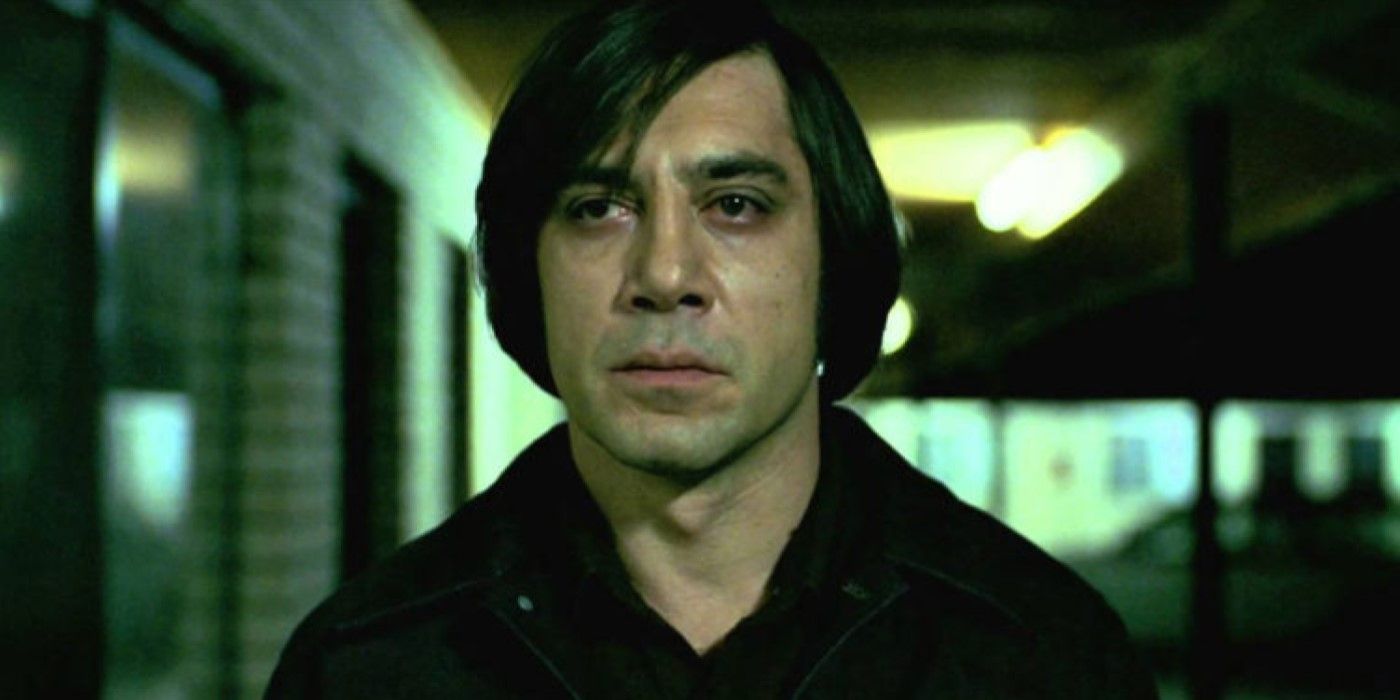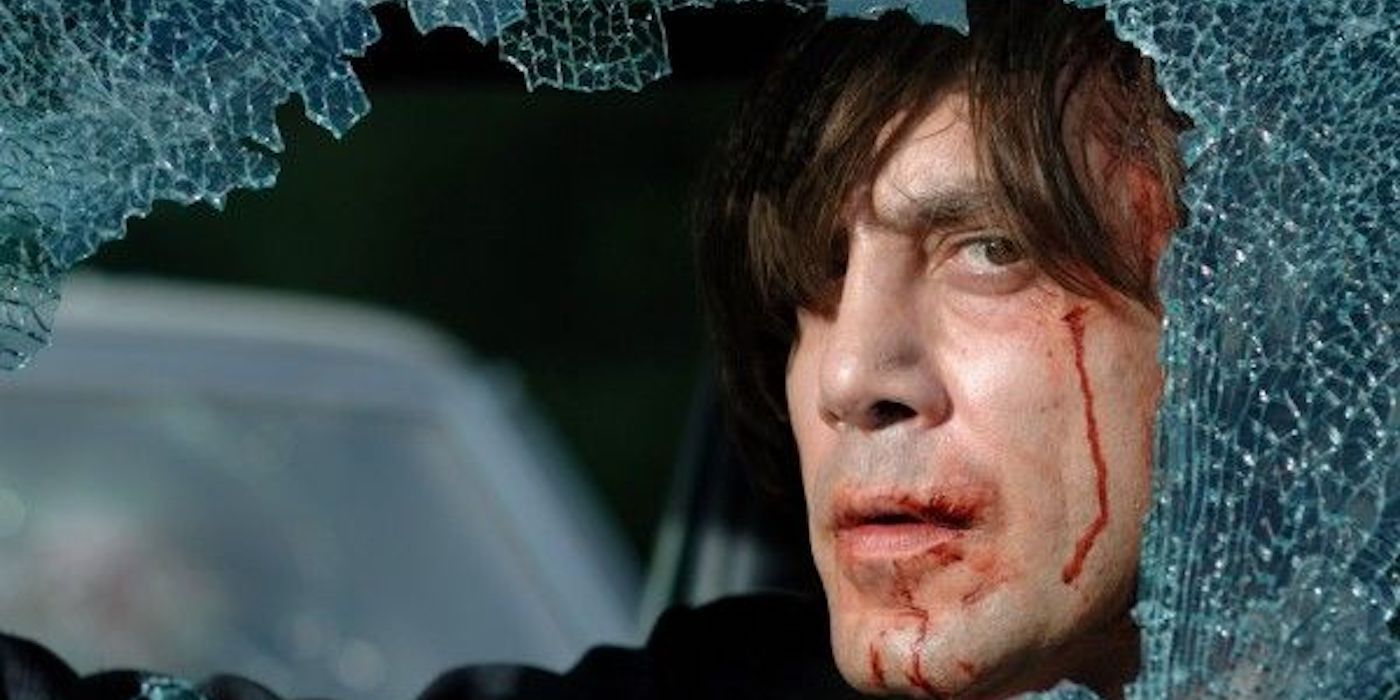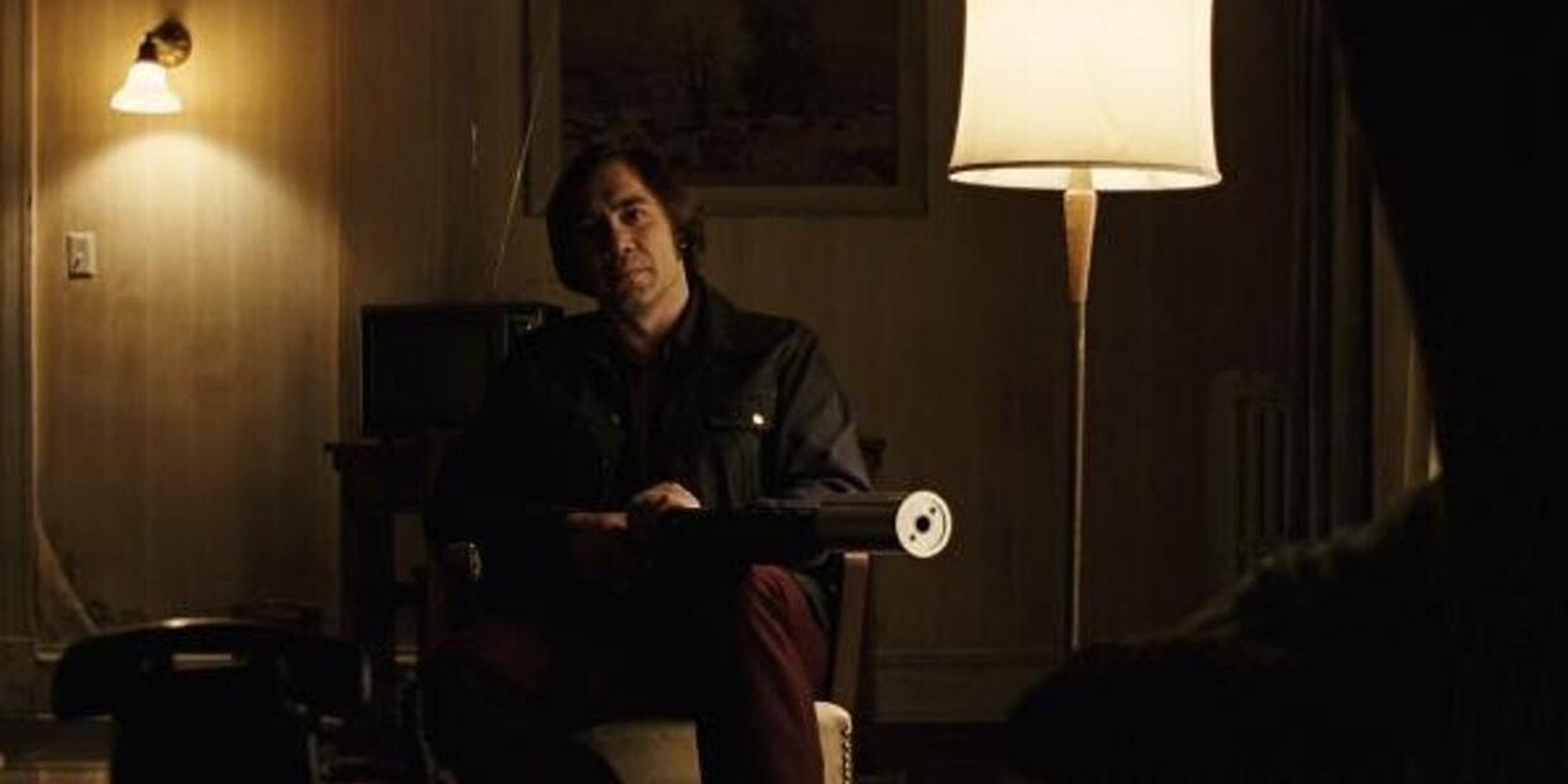Hollywood has a long, long history of psychopaths, some of them even on film. Michael Douglas‘ Gordon Gekko from Wall Street, The Silence of the Lambs‘ infamous Hannibal Lecter, brought to chilling life by Anthony Hopkins, or Kathy Bates‘ Annie Wilkes, whose skills with a sledgehammer are on full display in Misery, to name a few. However, if we were to look at which psychopaths in films exhibit the true traits of a psychopath, that list becomes much smaller. There is actually only one character, one performance that is cited as being the most realistic, and, surprisingly, it isn’t found in a horror movie. The movie is No Country for Old Men, and the character is Javier Bardem’s Oscar-winning Anton Chigurh.
What Are the Traits of a True Psychopath?
Now to understand what makes Anton Chigurh the most realistic psychopath on film, one has to understand exactly what makes a true psychopath. According to Psychology Today, the most common trait of psychopathy is an absence of empathy, while other affecting states are dulled. If that were all, of course, then it would be quite simple to ascertain if someone is a psychopath. Only the disorder is quite difficult to assess, as a psychopath can appear normal, not the axe-wielding, wide-eyed miscreant with the maniacal laugh stereotype. Other traits may point to psychopathy, like callousness, impulsivity, compulsive lying, the lack of a conscience, and a tendency towards antisocial behavior.
Psychopaths are, as told by criminologist Robert Blakey, “people who are detached from their own emotions and the emotions of other people.” Psychopathy shares traits with sociopathy, Antisocial Personality Disorder, and even autism, although the latter isn’t marked with the amorality that psychopaths exhibit. There is a checklist developed by Canadian researcher Robert Hare that, while not foolproof, does grade on superficial charm, manipulation, and even promiscuity. In the previously cited Psychology Today article, the bar for clinical psychopathy is a score of 30 or higher. To put that in perspective, serial killer Ted Bundy landed higher. 39, to be exact.
Anton Chigurh Checks All the Boxes in ‘No Country for Old Men’
In 2014, Belgian psychiatry professor Samuel Leistedt set out to look at which Hollywood psychopaths were the most accurate. With the help of ten others, Leistedt watched 400 movies over three years, from a period spanning 1915 to 2010. Based on realism and clinical accuracy (psychopaths with magic powers or those that are invincible – sorry, Jason – were purged), out of those 400 films they identified 126 fictional characters, 21 female and 105 male, that exhibited the traits of a psychopath. Right there, on the top of the list, is Anton Chigurh, the golden example of the primary, classic psychopath. It’s a portrayal that is admittedly Leistedt’s favorite, saying, “He [Chigurh] does his job and he can sleep without any problems.” In his practice, Leistedt has met people like him, with Chigurh bringing to mind two real-life professional hit men he interviewed once.
It’s a testament to the work of Bardem and the Coen Brothers that Chigurh earns such academic praise. From the film’s start, Bardem makes it clear that Chigurh is, for lack of a better word, a heartless beast. His first kill on-screen sets the precedent, where Chigurh kills his arresting police officer by choking him with his handcuffed wrists. There isn’t any frenzied action to move his hands from behind his back, there’s no running toward his prey across the room. As you look behind the officer in the foreground, everything Chigurh does is methodical and calculated. Unemotional. Even as he kills the man, his face remains devoid of, well, anything. After the officer’s death, Chigurh simply goes and washes his hands. Not scouring the blood off in some Shakespearian attempt to rid his hands of guilt-induced blood spots, just disturbingly normal. That lack of emotion is clear throughout the film, with the only smile on his face coming from putting his bolt gun to the head of an unsuspecting driver.
Another trait of the psychopath is presented in the infamous “coin toss” scene: dichotomous (black and white) thinking. Chigurh doesn’t tell the gas station clerk directly what the consequence is of choosing wrong, but is adamant that the clerk pick a side. The clerk asks questions like “Why do I need to pick a side?” or “What am I putting up?”, all perfectly normal questions. But that’s not picking a side. When the clerk finally does pick a side, thankfully the right one, Chigurh walks away. The man’s fate has been decided, clean and simple, without being muddied with shades of gray about his family, or his age, or pleas for mercy. That’s why towards the end of the film, when Carla Jean (Kelly Macdonald) flat out refuses to choose a side, it seems to throw Chigurh for a loop: there are only two options, not a third “none of the above” choice. Despite playing such a remorseless, unemotional character, the biggest issue that Bardem had with Chigurh was the haircut, which he described in his Oscar acceptance speech as, “one of the most horrible haircuts in history.” So bad, it reportedly sent him into a depression, with fellow actors claiming he was too ashamed to leave the house. Ironically, a true psychopath couldn’t care less about what people think of their haircut.
The Challengers to ‘No Country for Old Men’ Anton Chigurh’s Top Psychopath Standing
They say it’s lonely at the top. Anton Chigurh’s place as the top Hollywood psychopath is evidence of that, with only two other performances coming close to accurately depicting psychopathic behavior. As reported in the previously cited Business Insider, Peter Lorre‘s Hans Beckert from 1931’s M, a child-murderer, places second. Leistedt writes, “Lorre portrays Beckert as an outwardly unremarkable man tormented by a compulsion to murder children ritualistically,” leading to a diagnosis as a “pseudo psychopath” with psychosis. He’s also an example of a secondary psychopath as opposed to a primary, with Science News differentiating the two as genetics vs. environment. Capping off the top three is Henry Lee Lucas from Henry: Portrait of a Serial Killer, as played by Michael Rooker. Leistedt and colleague Paul Linkowski claim that the film captures the chaos and instability in the life of the psychopath, a lack of insight or empathy, and a failure to plan for the future.
One would expect Hannibal Lecter to be near the top, and likely Norman Bates (Anthony Perkins) as well, a safe assumption given that he’s in a movie actually called Psycho. However, neither fits the definition of a true psychopath. Bates would be diagnosed with psychosis, with traits like being out of touch with reality and the presence of delusions and hallucinations more in line with that diagnosis, as opposed to psychopathy, which typically doesn’t share those traits. It’s also more in line with American Psycho‘s Patrick Bateman (Christian Bale). As for Lecter, he’s seen as a prototypical “elite” psychopath, one with almost superhuman intelligence and cunning, traits that aren’t common in anyone, including your run-of-the-mill psychopaths.
Why Aren’t There More Realistic Psychopaths on Film?
According to psychotherapist Dr. Paul Hokemeyer, Hollywood depictions of psychopaths “overdramatize the traits found among psychopaths by having them brutally murder a slew of victims.” Leistedt goes even further, saying, “Psychopathic characters are generally unrealistic, accumulating many traits and characteristics such as sadism, intelligence, and the ability to predict the plan that the future victims will use to escape” (think Jason cutting off – pun intended – his victim’s escape route). So, if Hollywood largely misrepresents true psychopaths, why aren’t there more Anton Chigurh’s on film? Because they aren’t nearly as interesting. Let me explain. No disrespect to Bardem’s stunning performance (yes, pun intended), but his character works in the film because it’s not a horror movie. No Country for Old Men is a crime thriller, so the purpose of Chigurh in the film is to heighten the tension, the “thrill,” not to showcase inventive ways to kill. The horror genre, where psychopaths, or at least the popular stereotype of them, rule, depends on the killer to deliver the horror. They can lack emotion, but if so, they need to be unstoppable and proficient at their craft to compensate. But a psychopath with emotion, be it giddiness (Art the Clown seems to be enjoying himself in the Terrifier 3 trailer), anger, or otherwise, is even better, a counter-intuitive trait that somehow seems more “normal” than the complete lack of emotion that is representative of the real-world psychopath.
It also speaks to how horror audiences embrace the movie psychopath as a catharsis of the darkness within. Korina Jochim posits that “we live vicariously through these characters because they live out these shadow longings, which most of us won’t and shouldn’t allow ourselves to do.” There’s an appeal to that sense of irresponsibility and impulsiveness without fearing consequences, and, in a perverse, twisted way, that sense of satisfaction at doing something you love and enjoying your accomplishments. Then comes that relief when that “bad self” represented by the typical movie psychopath gets their comeuppance, even if it’s deferred to Jason Goes to Hell: The Final Friday or Freddy’s Dead: The Final Nightmare. Simply put, the prototypical psychopath of film can be related to, even strangely admired by, the moviegoer to at least some degree, whereas accurate psychopathic characters like Anton Chigurh and Henry are not as relatable.
Of course, the fabricated psychopath of film exists in that world, but in this world, psychopaths are not easy to identify, nor do they stand out in a crowd. There could even be one next to you as we speak, cradling a knife in one hand and a coin in the other, allowing the fates to decide if you make it home tonight. But if it’s any consolation, Dr. Hokemeyer did add that in real life, psychopaths seldom murder outright. Well, that’s certainly comforting, isn’t it? In a non-comforting-at-all way, that is. But here’s a helpful hint: if a guy with an air-powered captive bolt pistol and a bad haircut starts methodically walking your way, we suggest you run.
No Country for Old Men is available to stream on Paramount+ in the U.S.
WATCH ON PARAMOUNT+



